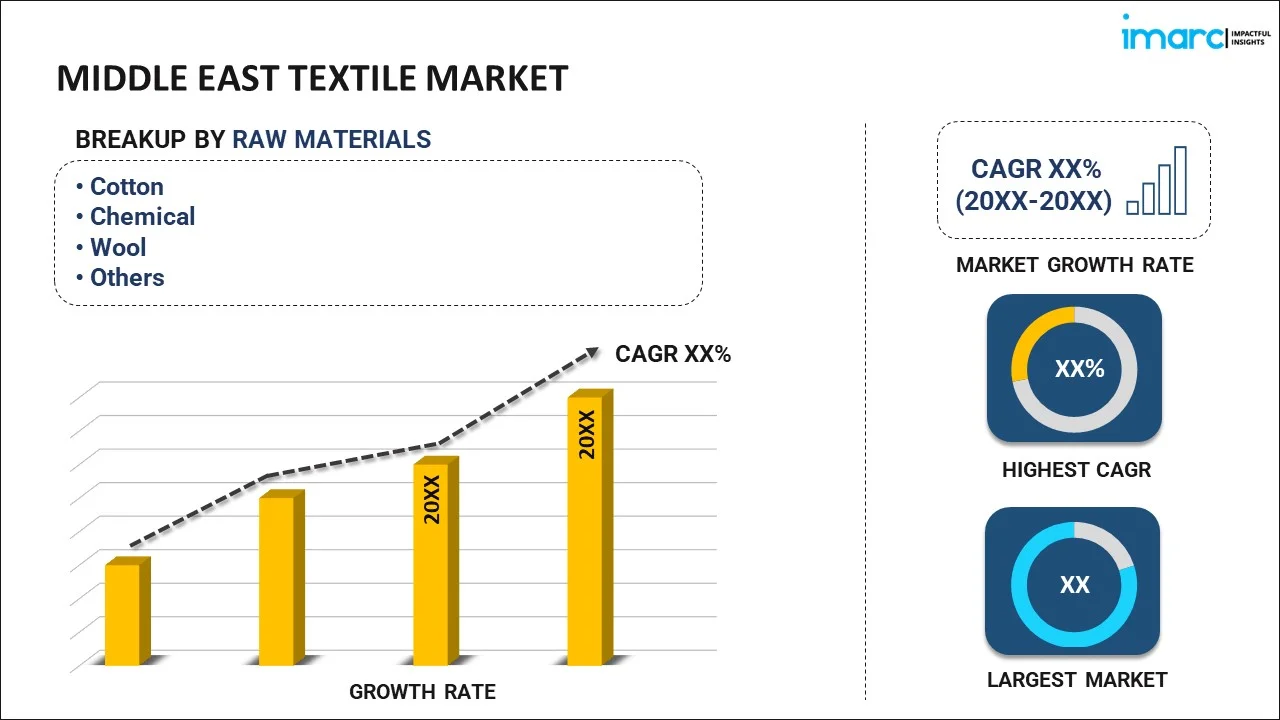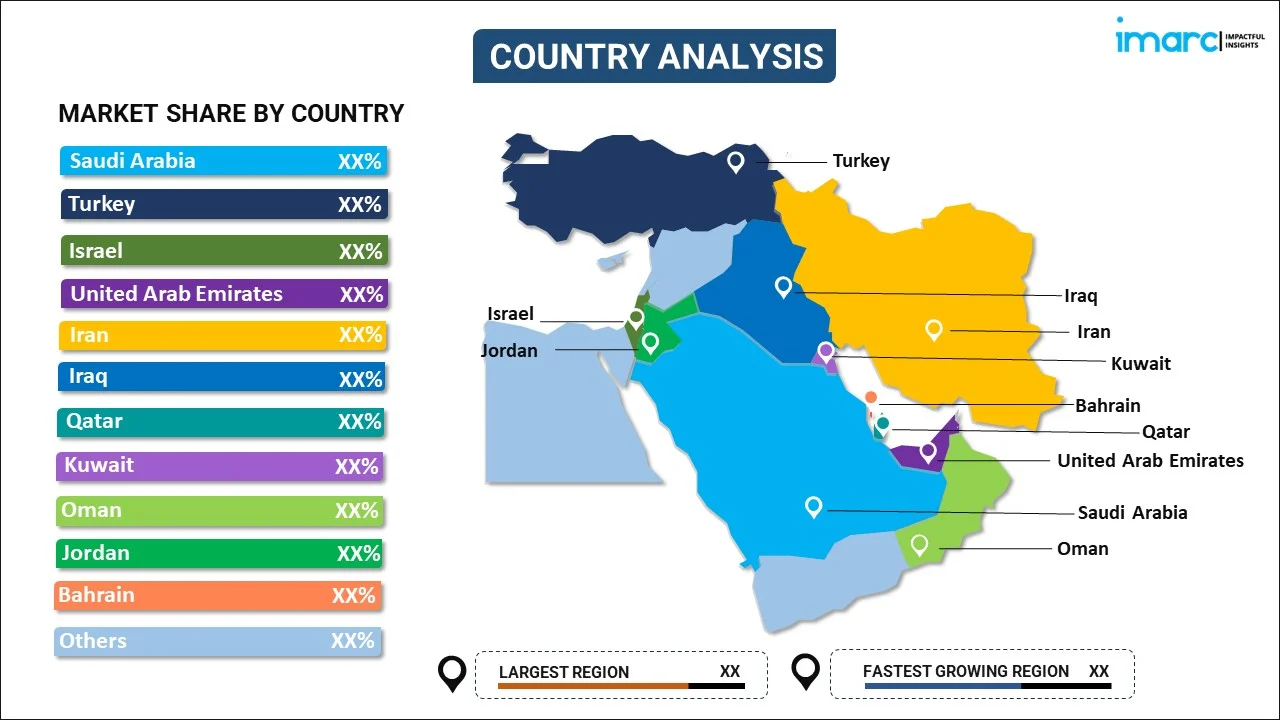
Middle East Textile Market Report by Raw Material (Cotton, Chemical, Wool, Silk, and Others), Product (Natural fibers, Polyesters, Nylon, and Others), Application (Household, Technical, Fashion and Clothing, and Others), and Country 2025-2033
Market Overview:
Middle East textile market size is projected to exhibit a growth rate (CAGR) of 6.82% during 2025-2033. The increasing innovations in textile manufacturing technologies, such as advanced weaving techniques, sustainable dyeing processes, and smart textiles, which can influence the efficiency of production processes, are driving the market.
|
Report Attribute
|
Key Statistics
|
|---|---|
|
Base Year
|
2024 |
|
Forecast Years
|
2025-2033
|
|
Historical Years
|
2019-2024
|
| Market Growth Rate (2025-2033) | 6.82% |
Textiles are an integral part of daily life, encompassing a diverse range of materials and products that serve both functional and aesthetic purposes. The textile industry, a dynamic and multifaceted sector, involves the production of fibers, yarns, fabrics, and finished goods such as clothing, home furnishings, and industrial materials. From natural fibers like cotton and wool to synthetic materials such as polyester and nylon, textiles play a crucial role in shaping the economy. Beyond their practical function, textiles also reflect cultural, social, and artistic expressions. Traditional textile techniques, handed down through generations, contribute to the rich tapestry of heritage. Moreover, technological advancements have revolutionized the industry, giving rise to innovations like smart textiles that integrate electronic components for enhanced functionality. As consumers become more conscious of their choices, the future of textiles lies in a balance between innovation, tradition, and responsible practices.
Middle East Textile Market Trends:
The textile market in the Middle East is experiencing dynamic growth, driven by various factors that intertwine to shape its trajectory. Firstly, the increasing regional population has spurred demand for textiles, as burgeoning numbers translate to a larger consumer base with diverse needs. Additionally, the rising disposable income across regions has elevated consumer spending on clothing, home textiles, and other fabric-based products. Moreover, the growing awareness and emphasis on sustainable practices have propelled the demand for eco-friendly and ethically produced textiles. Consumers are increasingly seeking products that align with their environmental values, fostering a shift towards sustainable materials and manufacturing processes. Furthermore, technological advancements in the textile industry, such as the development of smart fabrics and innovative manufacturing techniques, are creating new avenues for market expansion. In conclusion, a confluence of factors, including population growth, rising incomes, sustainability concerns, and technological innovations, collectively propels the textile market forward in the Middle East, shaping its evolution and driving its economic significance.
Middle East Textile Market Segmentation:
IMARC Group provides an analysis of the key trends in each segment of the market, along with forecasts at the regional and country levels for 2025-2033. Our report has categorized the market based on raw material, product, and application.
Raw Material Insights:

- Cotton
- Chemical
- Wool
- Silk
- Others
The report has provided a detailed breakup and analysis of the market based on the raw material. This includes cotton, chemical, wool, silk, and others.
Product Insights:
- Natural Fibers
- Polyesters
- Nylon
- Others
A detailed breakup and analysis of the market based on the product have also been provided in the report. This includes natural fibers, polyesters, nylon, and others.
Application Insights:
- Household
- Technical
- Fashion and Clothing
- Others
The report has provided a detailed breakup and analysis of the market based on the application. This includes household, technical, fashion and clothing, and others.
Country Insights:

- Saudi Arabia
- Turkey
- Israel
- United Arab Emirates
- Iran
- Iraq
- Qatar
- Kuwait
- Oman
- Jordan
- Bahrain
- Others
The report has also provided a comprehensive analysis of all the major regional markets, which include Saudi Arabia, Turkey, Israel, United Arab Emirates, Iran, Iraq, Qatar, Kuwait, Oman, Jordan, Bahrain, and Others.
Competitive Landscape:
The market research report has also provided a comprehensive analysis of the competitive landscape in the market. Competitive analysis such as market structure, key player positioning, top winning strategies, competitive dashboard, and company evaluation quadrant has been covered in the report. Also, detailed profiles of all major companies have been provided.
Middle East Textile Market Report Coverage:
| Report Features | Details |
|---|---|
| Base Year of the Analysis | 2024 |
| Historical Period | 2019-2024 |
| Forecast Period | 2025-2033 |
| Units | Million USD |
| Scope of the Report | Exploration of Historical and Forecast Trends, Industry Catalysts and Challenges, Segment-Wise Historical and Predictive Market Assessment:
|
| Raw Materials Covered | Cotton, Chemical, Wool, Silk, Others |
| Products Covered | Natural fibers, Polyesters, Nylon, Others |
| Applications covered | Household, Technical, Fashion and Clothing, Others |
| Countries Covered | Saudi Arabia, Turkey, Israel, United Arab Emirates, Iran, Iraq, Qatar, Kuwait, Oman, Jordan, Bahrain, Others |
| Customization Scope | 10% Free Customization |
| Post-Sale Analyst Support | 10-12 Weeks |
| Delivery Format | PDF and Excel through Email (We can also provide the editable version of the report in PPT/Word format on special request) |
Key Questions Answered in This Report:
- How has the Middle East textile market performed so far and how will it perform in the coming years?
- What has been the impact of COVID-19 on the Middle East textile market?
- What is the breakup of the Middle East textile market on the basis of raw material?
- What is the breakup of the Middle East textile market on the basis of product?
- What is the breakup of the Middle East textile market on the basis of application?
- What are the various stages in the value chain of the Middle East textile market?
- What are the key driving factors and challenges in the Middle East textile?
- What is the structure of the Middle East textile market and who are the key players?
- What is the degree of competition in the Middle East textile market?
Key Benefits for Stakeholders:
- IMARC’s industry report offers a comprehensive quantitative analysis of various market segments, historical and current market trends, market forecasts, and dynamics of the Middle East textile market from 2019-2033.
- The research report provides the latest information on the market drivers, challenges, and opportunities in the Middle East textile market.
- Porter's five forces analysis assist stakeholders in assessing the impact of new entrants, competitive rivalry, supplier power, buyer power, and the threat of substitution. It helps stakeholders to analyze the level of competition within the Middle East textile industry and its attractiveness.
- Competitive landscape allows stakeholders to understand their competitive environment and provides an insight into the current positions of key players in the market.
Need more help?
- Speak to our experienced analysts for insights on the current market scenarios.
- Include additional segments and countries to customize the report as per your requirement.
- Gain an unparalleled competitive advantage in your domain by understanding how to utilize the report and positively impacting your operations and revenue.
- For further assistance, please connect with our analysts.
 Inquire Before Buying
Inquire Before Buying
 Speak to an Analyst
Speak to an Analyst
 Request Brochure
Request Brochure
 Request Customization
Request Customization




.webp)




.webp)












